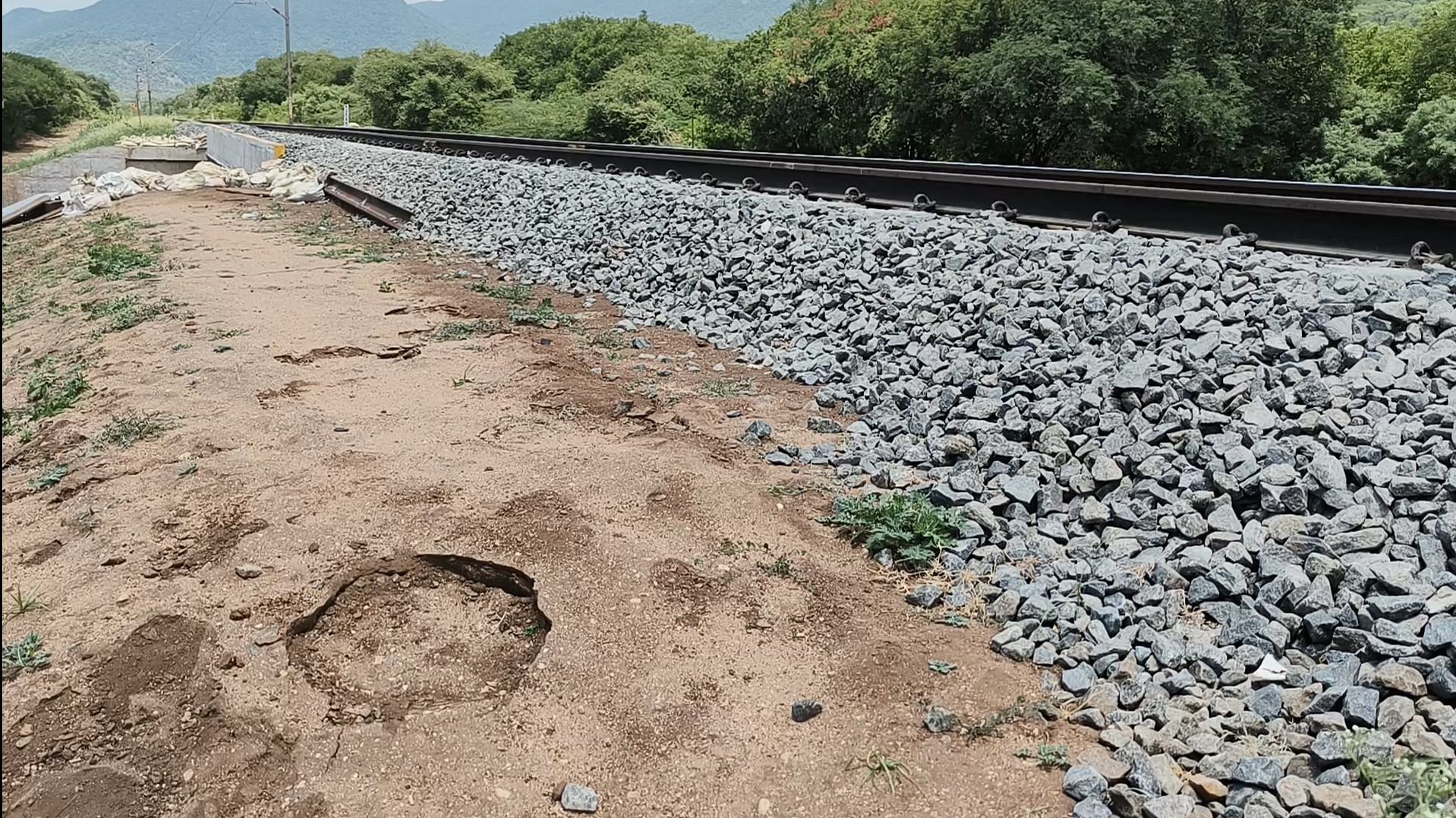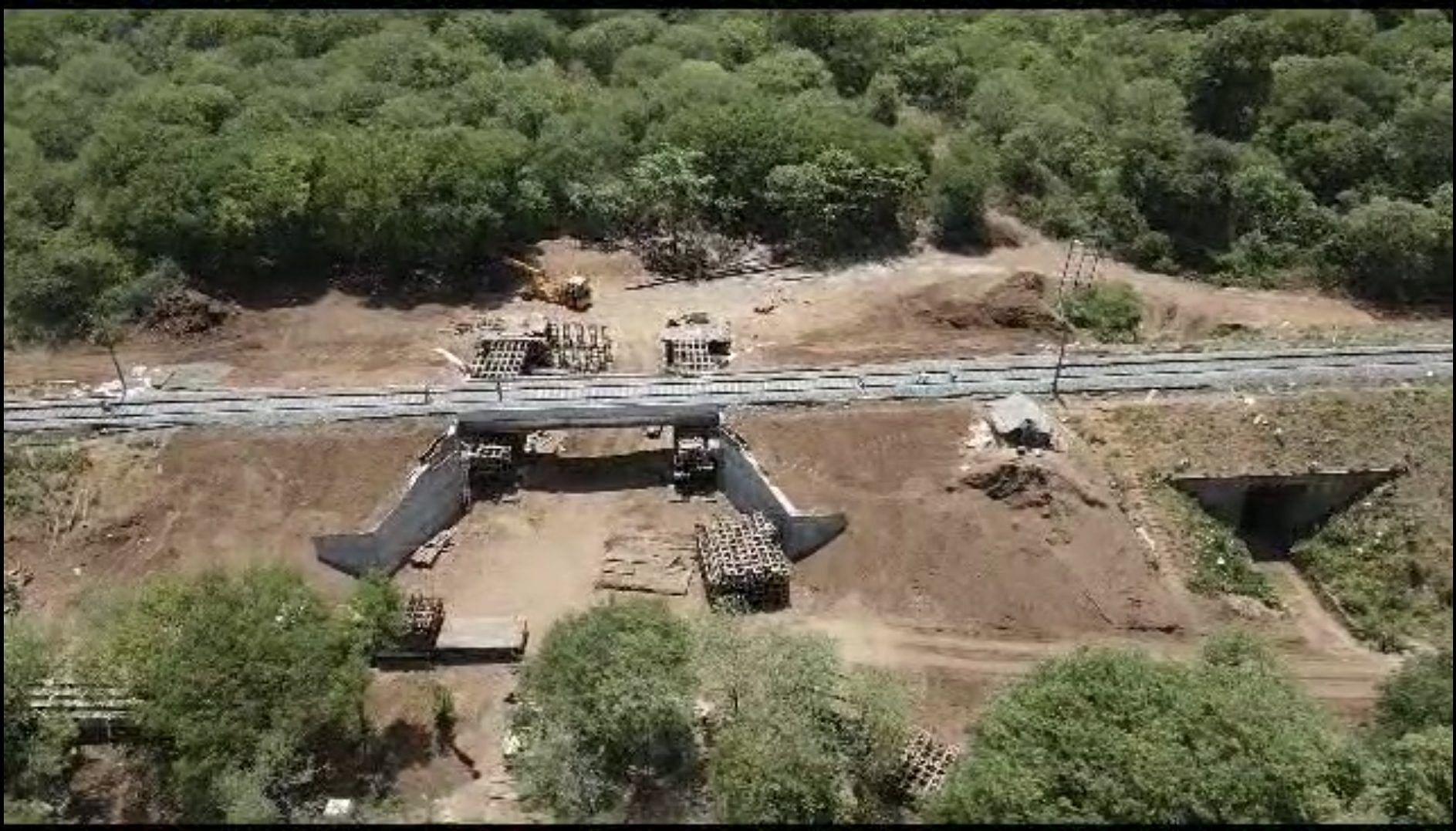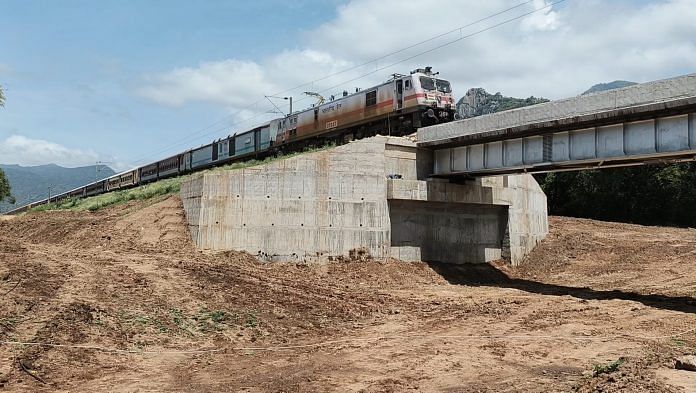Madukkarai: At 3.04 am on 23 August, a male elephant in the Madukkarai forest range near Coimbatore nonchalantly crossed the railway line in Sulakkarai, Virudhunagar. Surveillance cameras immediately pinged alerts, and Tamil Nadu’s forest and railway officials whooped with joy. This marked the first time an elephant had used the underpass worth Rs 7.5 crore, which the Southern Railways had built especially for them. Their two-month-long vigil had come to an end.
This muddy passage, over which an elevated railway line has been built, serves as the newest pilot project designed to steer elephants and other animals away from the collision path of trains. For months, all they saw were elephant footprints skirting around the underpass—almost as if the animals were suspicious of it.
So far, only one male tusker has used the underpass. But the authorities are hopeful that ‘word will spread’, and more elephants will use this safe-crossing zone in the coming months. A forest guard enthusiastically points to a heap of elephant dung—now dried up—next to the underpass.
“It’s a good sign,” he says. “It will help guide other elephants through this path. They will see it as a safe route.”

Another underpass on the same line will be built around 1.5 km away, and the tendering process is already underway. As many as 11 elephants have died on this 13-kilometre stretch since 2008, and most of the accidents in Tamil Nadu take place here, according to forest officials who have identified it as a vulnerable zone. They’ve spotted the lone male and a herd of six females in the area.
Although the underpass was commissioned in June, the machinery and construction debris was cleared only by mid-August. While the elephants may still be leery of using it, other forest denizens seem to be giving it a warmer welcome—of a sort. Cameras have captured footage of Indian gaur, spotted deer, and wild dogs using the new underpass.
It’s not easy to change an elephant or a herd’s roaming routes, and this may negate the effectiveness of the underpass. For now, they still prefer to climb up the slope and cross the railway track.
“Elephants stick to their regular paths. Once they get used to the underpass, they may not walk along the railway track,” said S Ramasubramanian, conservator of forests and field director of the Anamalai Tiger Reserve.
If they don’t, forest officials will create an “environment” that will prod the elephants to use the underpass. “We’ll raise barriers along their regular pathways,” said an official. There are also plans to cultivate vegetation that elephants prefer and station guards along the stretch and guide them toward the underpass.

Also read: In Assam, trains prey on elephants. But Haati Mitras, AI have been defeating them for 4 yrs
Crossing the first hurdle
Two railway tracks run through the Madukkarai forest range between Tamil Nadu’s Ettimadai and Kerala’s Walayar section—a 1.8-km A line and a 2.8-km B line. According to the Southern Railways, this is one of the busiest sections of the Palakkad, Coimbatore zone.
However, it is also a popular crossing area for elephants, who traverse the tracks between Ettimadai and Walayar, where the forest is dense. Sometimes, they stray into nearby villages and often remain in the forest patch sandwiched between the A and B lines.
The forest department has categorised about 13 km along both lines as an animal accident-prone zone. In Tamil Nadu, the Coimbatore forest division, covering an area of 694 sq km, is home to an estimated elephant population of around 363.
The idea of an underpass was initially discussed at an inter-ministerial meeting in 2010 but a 2021 report by the Central Project Elephant Monitoring Committee (CPEMC) stated that the underpasses were not constructed because “no funds were made available by the State Forest Department”. The green tribunal report also suggested the railways undertake the construction cost. On 10 April, Tamil Nadu forest officials and Southern Railway officials met to discuss the action plan.
“It was then decided that railways would undertake construction of two elephant (wildlife) underpasses, and the forest department would implement state-of-the-art surveillance using artificial intelligence and machine learning technology,” said Supriya Sahu, additional chief secretary of Tamil Nadu’s environment, climate change, and forests department.
Fortunately, the B line stretch was already on an elevated plateau. Instead of creating a new line or raising the existing one, they had to create a passage high enough for the elephants to walk under, while ensuring minimal disruption to train movement.
Wildlife experts, while appreciative of the forest department’s efforts, remain sceptical about the effectiveness of these underpasses.
“At present, only one elephant has crossed through the pass, and it is difficult to make all of them crossing the 13 km stretch use it,” said Mac Mohan, an animal rights activist from Coimbatore.
But Shravan Krishnan, director of Besant Memorial Animal Dispensary and member of Tamil Nadu state wildlife board, said the underpass is for other animals such as jackal and snakes as well. “In India, we don’t have too many of this kind. What they (the government) are trying to do makes sense. Most elephant-related accidents happen because of rail hits or electrocution. Other countries have highways with under or overpasses for the animals. Any step to revive and protect elephants is a welcoming move,” he said.
Work began in December 2022, with the Southern Railway first constructing two temporary girders or support beams to hold the railway line on top of a steep bund. All train movement was halted for nine hours, and most trains were rerouted via the A line. Once the temporary girders were in place and secure, train movement resumed, and construction activity proceeded underneath.
For seven months, the area buzzed with construction workers and heavy machinery.
“The construction work, the loud sounds, and the constant movement of vehicles and people caused many elephant herds to move to other parts of the forest,” said a forest guard.
Work on the underpass was completed on 10 June 2023. It measures 18 metres wide, 6 metres high, and 20 meters in length.
When the first elephant used it last month, forest officials were ecstatic. “We have a sense of accomplishment and gratitude for being able to work together as a team with railways, forest, revenue, and other departments,” Sahu said.
Also read: Arikomban is a wayward son of Kerala and a mini-celebrity. But where does he really belong?
AI to track movement
The next important stage involves monitoring elephant movements with the help of AI and drone technology as well as old-fashioned human surveillance. The department has installed thermal cameras at various points along the forest line and is testing an AI surveillance system, which will alert authorities when an elephant approaches the railway track.
“Both these systems will provide advance alerts if elephants are nearing the tracks, [helping] officials take immediate measures to prevent collisions,” she said.
If all else fails, there’s human intervention.
Currently, there are 19 forest field staff members on patrol duty, stationed along identified vulnerable zones. Armed with a matchbox and a set of crackers, two forest guards cautiously approach a bund where B line snakes through the forest.
The team is on high alert. A wild tusker in the area is experiencing musth, a period marked by heightened aggression and unpredictable behaviour linked to raised testosterone levels.
“We need to be very careful and very quick,” said a forest guard.
They will wait, ready to burst the crackers if an elephant comes close to the track. Hopefully, it will find the underpass.
(Edited by Prashant)



